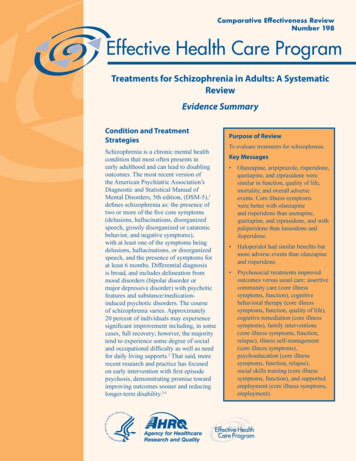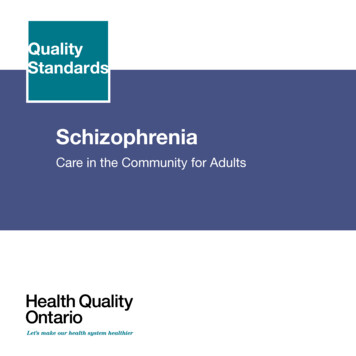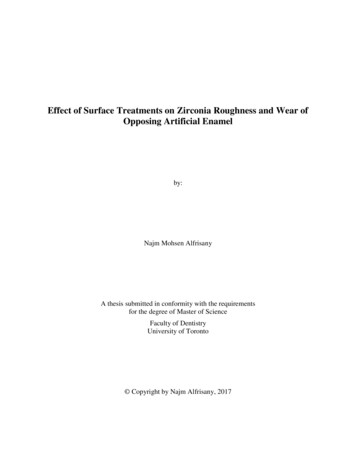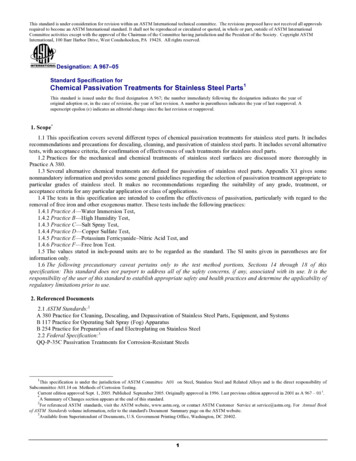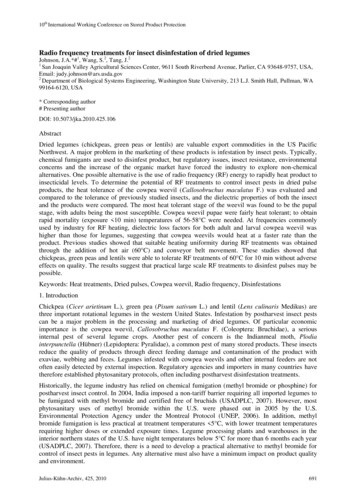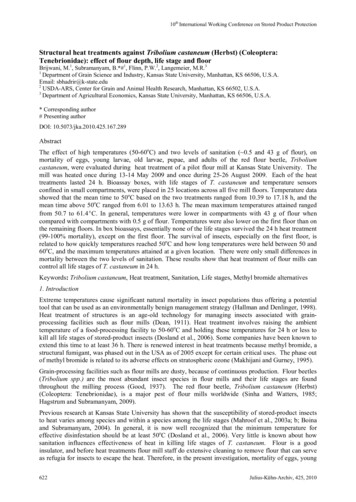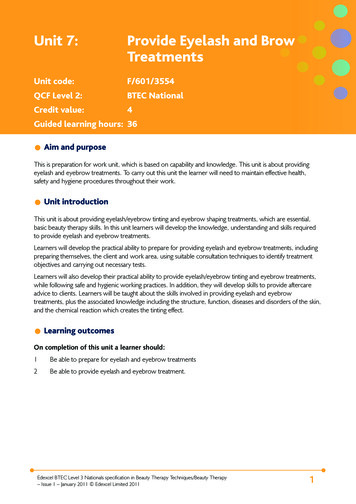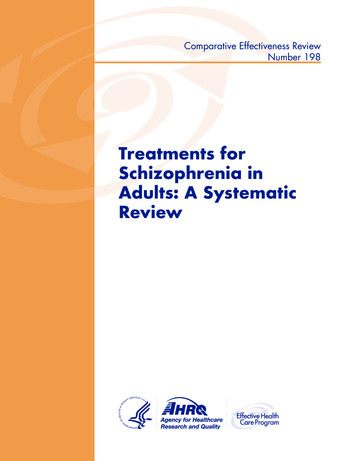
Transcription
Comparative Effectiveness ReviewNumber 198Treatments forSchizophrenia inAdults: A SystematicReviewe
Comparative Effectiveness ReviewNumber 198Treatments for Schizophrenia in Adults: A SystematicReviewPrepared for:Agency for Healthcare Research and QualityU.S. Department of Health and Human Services5600 Fishers LaneRockville, MD 20857www.ahrq.govContract No. 290-2015-00009-IPrepared by:Pacific Northwest Evidence-based Practice CenterPortland, ORInvestigators:Marian S. McDonagh, Pharm.D.Tracy Dana, M.L.S.Shelley Selph, M.D., M.P.H.Emily B. Devine, Pharm.D., Ph.D., M.B.A.Amy Cantor, M.D., M.P.H.Christina Bougatsos, M.P.H.Ian Blazina, M.P.H.Sara Grusing, B.A.Rochelle Fu, Ph.D.Sarah L. Kopelovich, Ph.D.Maria Monroe-DeVita, Ph.D.Daniel W. Haupt, M.D.AHRQ Publication No. 17(18)-EHC031-EFOctober 2017
Key MessagesPurpose of ReviewTo evaluate treatments for schizophrenia.Key Messages Olanzapine, aripiprazole, risperidone, quetiapine, and ziprasidone were similar infunction, quality of life, mortality, and overall adverse events. Core illness symptomswere better with olanzapine and risperidone than asenapine, quetiapine, and ziprasidone,and with paliperidone than lurasidone and iloperidone. Haloperidol had similar benefits but more adverse events than olanzapine andrisperidone. Psychosocial treatments improved outcomes versus usual care: assertive community care(core illness symptoms, function), cognitive behavioral therapy (core illness symptoms,function, quality of life), cognitive remediation (core illness symptoms), familyinterventions (core illness symptoms, function, relapse), illness self-management (coreillness symptoms), psychoeducation (core illness symptoms, function, relapse), socialskills training (core illness symptoms, function), and supported employment (core illnesssymptoms, employment).ii
This report is based on research conducted by the Pacific Northwest Evidence-based PracticeCenter (EPC) under contract to the Agency for Healthcare Research and Quality (AHRQ),Rockville, MD (Contract No. 290-2015-00009-I). The findings and conclusions in this documentare those of the authors, who are responsible for its contents; the findings and conclusions do notnecessarily represent the views of AHRQ. Therefore, no statement in this report should beconstrued as an official position of AHRQ or of the U.S. Department of Health and HumanServices.None of the investigators have any affiliations or financial involvement that conflicts withthe material presented in this report.The information in this report is intended to help health care decisionmakers—patients andclinicians, health system leaders, and policymakers, among others—make well-informeddecisions and thereby improve the quality of health care services. This report is not intended tobe a substitute for the application of clinical judgment. Anyone who makes decisions concerningthe provision of clinical care should consider this report in the same way as any medicalreference and in conjunction with all other pertinent information, i.e., in the context of availableresources and circumstances presented by individual patients.This report is made available to the public under the terms of a licensing agreement between theauthor and the Agency for Healthcare Research and Quality. This report may be used andreprinted without permission except those copyrighted materials that are clearly noted in thereport. Further reproduction of those copyrighted materials is prohibited without the expresspermission of copyright holders.AHRQ or U.S. Department of Health and Human Services endorsement of any derivativeproducts that may be developed from this report, such as clinical practice guidelines, otherquality enhancement tools, or reimbursement or coverage policies, may not be stated or implied.This report may periodically be assessed for the currency of conclusions. If an assessment isdone, the resulting surveillance report describing the methodology and findings will be found onthe Effective Health Care Program Web site at www.effectivehealthcare.ahrq.gov. Search on thetitle of the report.Persons using assistive technology may not be able to fully access information in this report. Forassistance contact epc@ahrq.hhs.gov.Suggested citation: McDonagh MS, Dana T, Selph S, Devine EB, Cantor A, Bougatsos C,Blazina I, Grusing S, Fu R, Kopelovich SL, Monroe-DeVita M, Haupt DW. Treatments forSchizophrenia in Adults: A Systematic Review. Comparative Effectiveness Review No. 198.(Prepared by the Pacific Northwest Evidence-based Practice Center under Contract No. 2902015-00009-I.) AHRQ Publication No. 17(18)-EHC031-EF. Rockville, MD: Agency forHealthcare Research and Quality; October l.cfm. DOI:https://doi.org/10.23970/AHRQEPCCER198.iii
PrefaceThe Agency for Healthcare Research and Quality (AHRQ), through its Evidence-basedPractice Centers (EPCs), sponsors the development of systematic reviews to assist public- andprivate-sector organizations in their efforts to improve the quality of health care in the UnitedStates. These reviews provide comprehensive, science-based information on common, costlymedical conditions, and new health care technologies and strategies.Systematic reviews are the building blocks underlying evidence-based practice; they focusattention on the strength and limits of evidence from research studies about the effectiveness andsafety of a clinical intervention. In the context of developing recommendations for practice,systematic reviews can help clarify whether assertions about the value of the intervention arebased on strong evidence from clinical studies. For more information about AHRQ EPCsystematic reviews, see .cfm.AHRQ expects that these systematic reviews will be helpful to health plans, providers,purchasers, government programs, and the health care system as a whole. Transparency andstakeholder input are essential to the Effective Health Care Program. Please visit the Web site(www.effectivehealthcare.ahrq.gov) to see draft research questions and reports or to join anemail list to learn about new program products and opportunities for input.If you have comments on this evidence report, they may be sent by mail to the Task OrderOfficers named below at: Agency for Healthcare Research and Quality, 5600 Fishers Lane,Rockville, MD 20857, or by email to epc@ahrq.hhs.gov.Arlene S. Bierman, M.D., M.S.DirectorCenter for Evidence and PracticeImprovementAgency for Healthcare Research and QualityGopal Khanna, M.B.A.DirectorAgency for Healthcare Research and QualityStephanie Chang, M.D., M.P.H.DirectorEvidence-based Practice Center ProgramCenter for Evidence and PracticeImprovementAgency for Healthcare Research and QualityDavid W. Niebuhr, M.D., M.P.H., M.Sc.Aysegul Gozu, M.D., M.P.H.Task Order OfficersCenter for Evidence and PracticeImprovementAgency for Healthcare Research and Qualityiv
AcknowledgmentsThe authors gratefully acknowledge the following individuals for their contributions to thisproject: Elaine Graham, M.L.S.; Andrew Hamilton, M.L.S., M.S.; Leah Williams, B.S.; RyanStoner, Ph.D.; Liev Miller, B.S.; and Brittany H. Lazur, M.P.H.Key InformantsIn designing the study questions, the EPC consulted several Key Informants who represent theend-users of research. The EPC sought the Key Informant input on the priority areas for researchand synthesis. Key Informants are not involved in the analysis of the evidence or the writing ofthe report. Therefore, in the end, study questions, design, methodological approaches, and/orconclusions do not necessarily represent the views of individual Key Informants.Key Informants must disclose any financial conflicts of interest greater than 10,000 and anyother relevant business or professional conflicts of interest. Because of their role as end-users,individuals with potential conflicts may be retained. The TOO and the EPC work to balance,manage, or mitigate any conflicts of interest.The list of Key Informants who provided input to this report follows:Anthony F. Lehman, M.D., M.S.P.H.University of MarylandCollege Park, MDBob Correia, R.Ph., Pharm.D.New York Medicaid Pharmacy AgencyNew York State Department of HealthNew York, NYJanie Marsh, M.P.H.:H.A.Mental Health America of OregonPortland, ORLisa B. Dixon, M.D., M.P.H.*Columbia UniversityNew York, NYPiper Meyer-Kalos, Ph.D., L.P.University of MinnesotaMinneapolis, MNLaura J. Fochtmann, M.D., M.B.I.*Departments of Psychiatry, PharmacologicalSciences and Biomedical InformaticsStony Brook University School of MedicineStony Brook, NYJoyce M. Shea, D.N.Sc., A.P.R.N.,P.M.H.C.N.S.-B.C.American Psychiatric Nurses AssociationFalls Church, VA*Provided input on Draft Reportv
Technical Expert PanelIn designing the study questions and methodology at the outset of this report, the EPC consultedseveral technical and content experts. Broad expertise and perspectives were sought. Divergentand conflicting opinions are common and perceived as healthy scientific discourse that results ina thoughtful, relevant systematic review. Therefore, in the end, study questions, design,methodologic approaches, and/or conclusions do not necessarily represent the views ofindividual technical and content experts.Technical Experts must disclose any financial conflicts of interest greater than 10,000 and anyother relevant business or professional conflicts of interest. Because of their unique clinical orcontent expertise, individuals with potential conflicts may be retained. The TOO and the EPCwork to balance, manage, or mitigate any potential conflicts of interest identified.The list of Technical Experts who provided input to this report follows:VA San Diego Healthcare SystemSan Diego, CAAustin R. Campbell, Pharm.D.University of MissouriColumbia, MOLisa Hartling, M.D.Alberta Research Centre for HealthEvidenceEdmonton, Alberta, CanadaLisa B. Dixon, M.D., M.P.H.*Columbia UniversityNew York, NYPiper Meyer-Kalos, Ph.D., L.P.University of MinnesotaMinneapolis, MNLaura J. Fochtmann, M.D., M.B.I*.Departments of Psychiatry, PharmacologicalSciences and Biomedical InformaticsStony Brook University School of MedicineStony Brook, NYMatthew V. Rudorfer, M.D.*National Institutes of HealthNational Institute of Mental HealthBethesda, MDEric Granholm, Ph.D.*Department of Psychiatry, University ofCalifornia, San Diego*Provided input on Draft Reportvi
Peer ReviewersPrior to publication of the final evidence report, EPCs sought input from independent Peerreviewers without financial conflicts of interest. However, the conclusions and synthesis of thescientific literature presented in this report do not necessarily represent the views of individualreviewers.Peer Reviewers must disclose any financial conflicts of interest greater than 10,000 and anyother relevant business or professional conflicts of interest. Because of their unique clinical orcontent expertise, individuals with potential nonfinancial conflicts may be retained. The TOOand the EPC work to balance, manage, or mitigate any potential nonfinancial conflicts of interestidentified.The list of Peer Reviewers follows:Lynn Bufka, Ph.D.American Psychological AssociationWashington, DCScott Stroup, M.D., M.P.H.Columbia UniversityNew York, NYKim Mueser, Ph.D.Boston UniversityBoston, MAAnn Wheeler, Pharm. D., B.C.P.P.United HealthcareOregon Health & Science UniversityPortland, ORvii
Treatments for Schizophrenia in Adults: A SystematicReviewStructured AbstractObjectives. This systematic review (SR) provides evidence on pharmacological andpsychosocial treatments for schizophrenia.Data sources. MEDLINE , the Cochrane Library databases, PsycINFO , and included studiesthrough February 2017.Study selection. We included studies comparing second-generation antipsychotics (SGA) witheach other or with a first-generation antipsychotic (FGA) and studies comparing psychosocialinterventions with usual care in adults with schizophrenia.Data extraction. We extracted study design, year, setting, country, sample size, eligibilitycriteria, population, clinical and intervention characteristics, results, and funding source.Results. We included 1 SR of 138 trials (N 47,189) and 24 trials (N 6,672) for SGAs versusSGAs, 1 SR of 111 trials (N 118,503) and 5 trials (N 1,055) for FGAs versus SGAs, and 13SRs of 271 trials (N 25,050) and 27 trials (n 6,404) for psychosocial interventions. Trials weremostly fair quality and strength of evidence was low or moderate. For drug therapy, the majorityof the head-to-head evidence was on older SGAs, with sparse data on SGAs approved in the last10 years (asenapine, lurasidone, iloperidone, cariprazine, brexpiprazole) and recent long-actinginjection (LAI) formulations of aripiprazole and paliperidone. Older SGAs were similar inmeasures of function, quality of life, mortality, and overall adverse events, except thatrisperidone LAI had better social function than quetiapine. Core illness symptoms wereimproved more with olanzapine and risperidone than asenapine, quetiapine, and ziprasidone, andmore with paliperidone than lurasidone and iloperidone; all were superior to placebo.Risperidone LAI and olanzapine had less withdrawal due to adverse events. Compared witholanzapine and risperidone, haloperidol, the most studied FGA, had similar improvement in coreillness symptoms, negative symptoms, symptom response, and remission but greater incidence ofadverse event outcomes. In comparison with usual care, most psychosocial interventionsreviewed were more effective in improving intervention-targeted outcomes, including coreillness symptoms. Various functional outcomes were improved more with assertive communitytreatment, cognitive behavioral therapy, family interventions, psychoeducation, social skillstraining, supported employment, and early interventions for first episode psychosis (FEP) thanwith usual care. Quality of life was improved more with cognitive behaviora
Treatments for Schizophrenia in Adults: A Systematic Review . Prepared for: Agency for Healthcare Research and Quality . U.S. Department of Health and Human Services . 5600 Fishers Lane . Rockville, MD 20857 . www.ahrq.gov . Contract No. 290-2015-00009-I . Prepared by: Pacific Northwest Evidence-based Practice Center . Portland, OR . Investigators:
